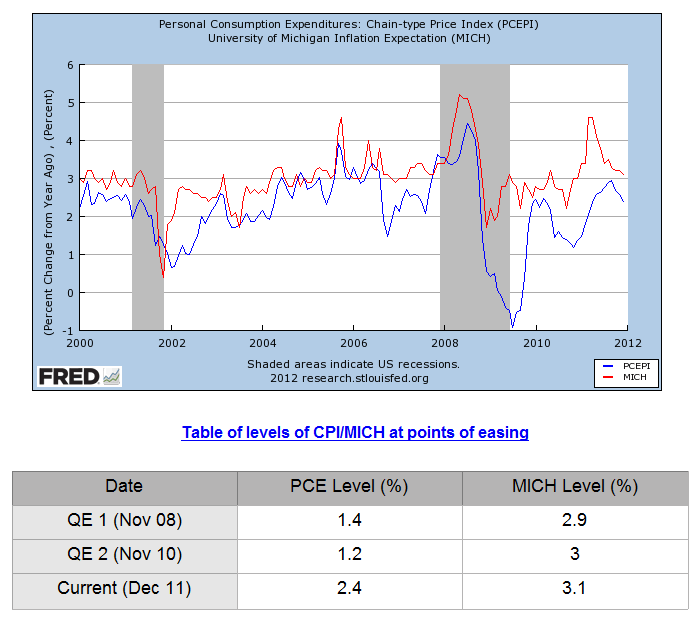Timing the Market: Predicting When the FED Will Act Next (Feb 12)
Stock-Markets / Inflation Feb 07, 2012 - 12:34 PM GMTBy: Chris_Riley
 Sadly, we have reached the point where markets are largely driven by government & central bank action. Their principle policy tool is monetary easing, which is used to shoot-up markets, against a market driven backdrop of de-levering. So in order to predict what the actors are likely to do, we need to understand the political constraints & incentives that they find themselves under: the principle actors being the central bankers and their politician friends.
Sadly, we have reached the point where markets are largely driven by government & central bank action. Their principle policy tool is monetary easing, which is used to shoot-up markets, against a market driven backdrop of de-levering. So in order to predict what the actors are likely to do, we need to understand the political constraints & incentives that they find themselves under: the principle actors being the central bankers and their politician friends.
In trying to assess these political constraints, it seems fairly obvious that the high levels of unemployment and bankruptcy that are necessary to clear out the system, are deemed unacceptable to this governing class. It would be unpopular politically and a toxic environment for the banks. But on the other hand, we have seen the impact of high inflation in terms of the civil disorder it can cause around the world. It is certainly not in the interest of the central bank or politicians to have anarchy on the street either, leading to the loss of their power. It thus follows that the incentive structure currently in place is to inflate to the maximum possible extent to relieve short-term economic pressure, subject to the CPI not breaching a certain level: the CPI is the central banker's chosen inflation measure and as a statistical construct, it is easily subject to manipulation (see my article: CPI - A Standard of Living Problem).
So now we have the basic construct in place, we can examine the current market using the FED’s new preferred CPI measure:

In terms of expectations (MICH) it would seem that the FED is quite content to pursue easing at these levels. This rate has recently come down from around the 4.6% level that may have been deemed dangerous by the FED. However, it is a different story when we look at the CPI level. At 2.4% it is higher than during previous easing episodes. It peaked recently at around 3% and is now in a downward trajectory. It is possible that the FED may be less CPI sensitive this time around and could begin QE3 at a higher level than contemplated previously, of say 2%. There are some big monthly increases to drop out of the annualised CPI calculation from Q1 2011 (around 1.2%), at which point the annualised CPI number could drop significantly and prove to be the magic bullet for more easing. This is looking highly likely since the seasonally adjusted Q4 2011 came in at just 0.1%!
As a final point, it is worth noting that if the US government begins to have trouble financing its huge deficit, then the political incentive structure changes radically for the actors involved: If the government is likely to fall anyway, then the actors may as well inflate to the amount necessary to finance the deficit and stay in power, regardless of current CPI levels. Such an incentive structure would lead to inflationary action beyond that currently deemed politically acceptable. We should be aware of this, but for now at least, hyperinflation is not in the interests of the central bankers or the politicians.
Conclusion
There is likely to be more easing this year, probably in late Q1/early Q2 2012 as the officially acknowledged CPI figure drops below that deemed politically acceptable. I expect that commodity prices will continue to be the biggest beneficiaries from the easing and will move in advance of the easing. This will itself present problems further down the road as the commodity price increases feed through into the official CPI measure, at which point “inflation” will become the major political concern again and policy will have to become more restrictive. This will spell danger for the future.
By Chris Riley
For more articles and charts, check-out my new website: www.goldbugz.co.uk
© 2012 Copyright Chris Riley - All Rights Reserved
Disclaimer: The views expressed in this article are those of the author and may not reflect those of Neptune Global Holdings LLC (Neptune). The author has made every effort to ensure accuracy of information provided; however, neither Neptune Global Holdings LLC nor the author can guarantee such accuracy. This article is strictly for informational purposes only and a sampling of diverse editorial opinion. It is not a solicitation to make any exchange in precious metal products, commodities, securities or other financial instruments. Neptune Global Holdings LLC and the author of this article do not accept culpability for losses and/ or damages arising from the use of this publication. Neptune does not act as, nor offer the services of, an investment advisor. Individuals should conduct their own due diligence before making any investment choices.
© 2005-2022 http://www.MarketOracle.co.uk - The Market Oracle is a FREE Daily Financial Markets Analysis & Forecasting online publication.



